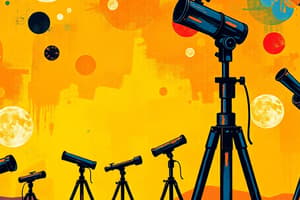Podcast
Questions and Answers
Refracting telescopes use a lens called the ______ lens to bend light and form an image.
Refracting telescopes use a lens called the ______ lens to bend light and form an image.
objective
Reflecting telescopes use a ______ mirror to gather light and avoid chromatic aberration.
Reflecting telescopes use a ______ mirror to gather light and avoid chromatic aberration.
concave
The ______ power of a telescope is its ability to distinguish between close objects, creating sharper images.
The ______ power of a telescope is its ability to distinguish between close objects, creating sharper images.
resolving
Radio telescopes can detect ______ waves, which are much longer than visible light waves.
Radio telescopes can detect ______ waves, which are much longer than visible light waves.
One advantage of radio telescopes is that they can operate ______, making them versatile for continuous observation.
One advantage of radio telescopes is that they can operate ______, making them versatile for continuous observation.
Flashcards
Refracting Telescope
Refracting Telescope
A type of telescope that uses a lens to bend and focus light, forming an image at a focal point. The image is further magnified by an eyepiece lens.
Reflecting Telescope
Reflecting Telescope
A type of telescope that uses a concave mirror to gather and focus light, avoiding color distortion.
Resolving Power
Resolving Power
The ability of a telescope to distinguish between closely spaced objects, resulting in clearer and more detailed images.
Light-Gathering Power
Light-Gathering Power
Signup and view all the flashcards
Radio Telescopes
Radio Telescopes
Signup and view all the flashcards
Study Notes
Refracting Telescopes
- Use a lens (objective lens) to bend light and form an image.
- Light converges at a focal point.
- Focal length is the distance between the lens and the focal point.
- An eyepiece lens magnifies the image.
- Suffer from chromatic aberration (color distortion).
Reflecting Telescopes
- Use a concave mirror to gather light.
- Avoid chromatic aberration.
- Most large telescopes are reflecting telescopes.
Optical Telescope Properties
Light-Gathering Power
- Larger lenses/mirrors collect more light, resulting in brighter images.
Resolving Power
- Ability to distinguish between close objects, creating sharper images with finer detail.
Magnifying Power
- Calculated by dividing the objective focal length by the eyepiece focal length.
- Magnification can be adjusted by changing the eyepiece.
- Limited by atmospheric conditions and the telescope's resolving power.
- Poor viewing occurs when stars "twinkle."
- Even the largest telescopes show stars (except the Sun) as points of light.
Detecting Invisible Radiation
- Photographic films: Used to detect ultraviolet and infrared light.
- Atmospheric limitations: Many invisible wavelengths are blocked by Earth's atmosphere.
- Balloons, rockets, and satellites are used to detect these wavelengths.
Radio Telescopes
- Radio waves: Reach Earth's surface.
- Collected by large dishes (radio telescopes).
- Radio waves are much longer than visible light waves (about 100,000 times longer).
- Often made of wire mesh.
- Have limited resolution.
- Multiple radio telescopes can be linked to create a radio interferometer for enhanced resolution.
Advantages of Radio Telescopes over Optical Telescopes
- Weather: Less affected by weather conditions.
- Cost: Generally less expensive than optical telescopes.
- Availability: Can operate 24/7.
- Detection: Can detect materials that don't emit visible light.
- Penetration: Can penetrate interstellar dust clouds.
Studying That Suits You
Use AI to generate personalized quizzes and flashcards to suit your learning preferences.




